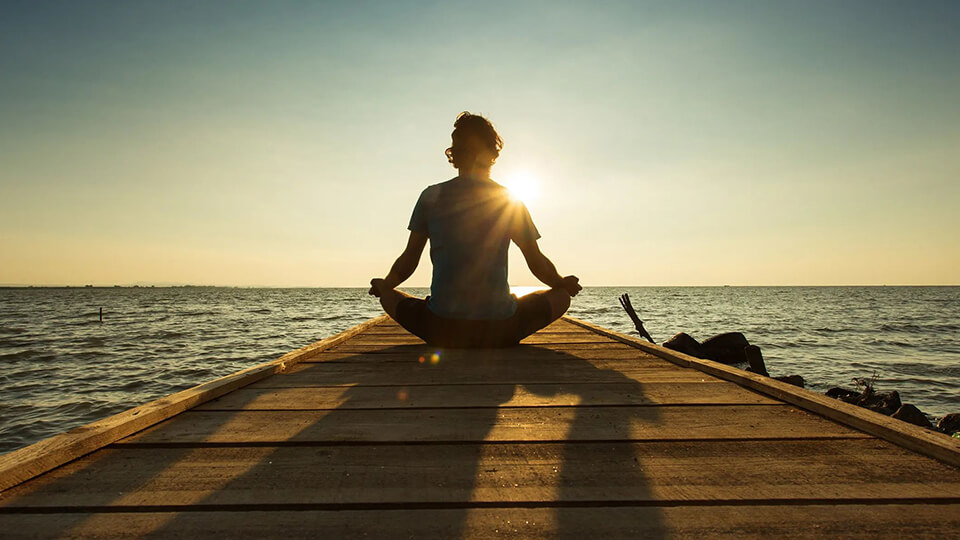Meditation for Stress Relief: The Relaxation Response Revealed
Life can be stressful. In fact, some experts estimate that between 60 and 90 percent of doctor’s visits are stress related. Though occasional stress is normal, chronic stress can have significant negative impacts on our health.
While we cannot prevent stress, we can lessen the harmful effects of our reaction to it. The Relaxation Response is the opposite of the stress response. By practicing the Relaxation Response, you can cancel some of the harmful effects of your body’s stress hormones. We can achieve the Relaxation Response through meditation.
Together with nutrition, exercise, and stress management, the Relaxation Response has been proven to be an effective adjunctive treatment for many diseases. Meditation is one way to calm the body and mind. We’ll take a close look at meditation, including what it is, how it works, and how to meditate to induce the Relaxation Response.
Our Body’s Stress Response:
- Release of adrenaline into the bloodstream
- Tight muscles and muscle twitching
- Increased heart rate
- Rapid breathing
- Halted digestion and upset stomach
- Emotional distress and sadness
- Teeth grinding
- Headache
- Poor concentration
Our Body’s Relaxation Response:
- Lower blood pressure
- Decreased muscle tension
- Slower heart rate
- Slower breathing rate
- Improved sense of mental and spiritual well-being
- Increase in alpha brain waves, which is associated with relaxation
- Decreased metabolism and reduced oxygen use
Conditions Worsened by Stress
- Heart disease
- Stroke
- Depression
- Low back pain
- Insomnia
- Irritable bowel syndrome
Conditions Improved by the Relaxation Response
- Heart disease
- Infertility
- Anxiety and depression
- Chronic pain
- Insomnia
- Premenstrual syndrome
- Cancer symptoms
- Immunodeficiency disorders
It is important to note that meditation should not be used as a primary or sole treatment of these conditions. However, to the extent that any disease is caused or made worse by stress, the Relaxation Response can help.

What Is Meditation?
Meditation has been used for thousands of years to connect the mind and body and improve feelings of acceptance, calmness, and relaxation. This practice involves focusing the mind’s attention and accepting—but letting go of—whatever thoughts may arise at the time.
There are many different types of meditation, all with different goals and approaches. In most cases, however, meditation involves the four following elements:
- Finding a comfortable posture (whether sitting, lying down, or otherwise)
- Practicing in a quiet, distraction-free environment
- Focusing one’s attention (typically on the breath, an object, or repeated mantra)
- Maintaining an open, accepting attitude (allowing thoughts or distractions to arise without judging or dwelling on them).
Relaxation-Response Meditation
The most widely used meditation course for stress is based on the concept of the “Relaxation Response”—a concept introduced by Dr. Herbert Benson in the 1960s and 1970s. Dr. Benson is often cited as “demystifying” the practice of meditation and bringing it into the mainstream Western consciousness.
As we will explore below, this stress-reduction meditation practice is aimed to counteract the body’s stress response and replace it with a feeling of deep relaxation.
What Is the “Relaxation Response?”
When we are stressed, hormones like adrenaline are released into our bloodstream and cause the body’s stress reaction (known as “fight or flight”). This can create a cascade of bodily changes, including sweaty palms, palpitations, nervousness, and anxiety, just to name a few.
The Relaxation Response can be thought of as the opposite of the stress response. It can help to return the body to its pre-stress state and “switch off” the fight-or-flight response. This deep relaxation can, in turn, lower blood pressure, slow the heart rate and breathing rate, decrease metabolism, decrease muscle tension, and produce a sense of mental and spiritual well-being.
Whether we “feel” it as a calming, relaxing experience or not, the health benefits of inducing the Relaxation Response are measurable, predictable, and repeatable.
Together with nutrition, exercise, and stress management, the Relaxation Response has been proven to be an effective adjunctive treatment in many diseases, including high blood pressure, insomnia, anxiety, and depression. The technique is used to treat many stress-related disorders and, to the extent that any disease is caused or made worse by stress, the Relaxation Response can help.

How to Produce the Relaxation Response
According to experts, it is best to practice the Relaxation Response first thing in the morning. Practicing once or twice a day for 10 to 20 minutes at a time can help negate the body’s stress response and lead to feelings of deep relaxation.
There Are Two Necessary Steps to Produce the Relaxation Response:
- Repeat a word, sound, phrase, prayer, or muscle action.
-choose a word or short phrase that is firmly rooted in your belief system, such as “one,” “peace,” “The Lord is my shepherd,” or “shalom.”
– or choose any soothing, mellifluous [sweet-sounding] sound, preferably with no meaning, or association, to avoid stimulation of unnecessary thoughts.
- Ignore everyday thoughts that come to mind and return to your repetition.
You can practice the Relaxation Response using the following six steps, taken word-for-word from Dr. Herbert Benson’s book, The Relaxation Response.
- Sit quietly in a comfortable position.
- Close your eyes.
- Deeply relax all your muscles, beginning at your feet and progressing up to your face. Keep them relaxed.
- Breathe through your nose. Become aware of your breathing. As you breathe out, say the word, “one,” silently to yourself. For example, breathe in…out, “one,” in … out, “one,” and so forth. Breathe easily and naturally.
- Continue for 10 to 20 minutes. You may open your eyes to check the time, but do not use an alarm. When you finish, sit quietly for several minutes, at first with your eyes closed and later with your eyes opened. Do not stand up for a few minutes.
- Do not worry about whether you are successful in achieving a deep level of relaxation. Maintain a passive attitude and permit relaxation to occur at its own pace. When distracting thoughts occur, try to ignore them by not dwelling upon them and return to repeating “one.” With practice, the response should come with little effort. Practice the technique once or twice daily, but not within two hours after any meal, because the digestive processes seem to interfere with the elicitation of the Relaxation Response.
Limitations of Meditation
While meditation can help to treat and prevent many conditions, it is important to recognize its limitations. Meditation may be used to help prevent a heart attack or stroke. However, once a heart attack or stroke has occurred, you will need medical treatment. Though meditation can be used as an adjunct to cope with your condition and can help to prevent a recurrence, the primary treatment will be medical.
If practiced regularly, the Relaxation Response can help us to fight stress. Try the steps above, apply the “active ingredient” in meditation to life’s stresses, and feel the benefits!
Copyright myObMD. Media, LLC, 2021 | Written by: Marilyn Radke, MD Oct 7, 2021 | Editor: Victoria Menard | Reviewed December 6, 2021.
References
- Radke, Marilyn S. “Relax and Enjoy Your Holidays,” Live Well, NARFE Magazine (National Active and Retired Federal Employees), Volume 81, No. 12. December 2005.
- Benson, Herbert MD with Klipper, Miriam Z, The Relaxation Response. Published 1975, William Morrow and Company, Inc. 1975.
- Martin, Sarah. “The Power of the Relaxation Response.” American Psychological Association, vol. 39, no. 9, Oct. 2008, p. 32.
- “Chronic Stress Puts Your Health at Risk.” Mayo Clinic, Mayo Foundation for Medical Education and Research, 8 July 2021, https://www.mayoclinic.org/healthy-lifestyle/stress-management/in-depth/stress/art-20046037.
- “A Beginner’s Guide to Meditation.” Mayo Clinic, Mayo Foundation for Medical Education and Research, 22 Apr. 2020, https://www.mayoclinic.org/tests-procedures/meditation/in-depth/meditation/art-20045858.
- Mitchell, Marilyn. “Dr. Herbert Benson’s Relaxation Response.” Psychology Today, 29 Mar. 2013, https://www.psychologytoday.com/us/blog/heart-and-soul-healing/201303/dr-herbert-benson-s-relaxation-response.
- “Meditation: In Depth.” National Center for Complementary and Integrative Health, U.S. Department of Health and Human Services, Apr. 2016, https://www.nccih.nih.gov/health/meditation-in-depth.
- Affairs, MGH Public. “Mindfulness Meditation and Relaxation Response Affect Brain Differently.” Harvard Gazette, Harvard Gazette, 24 July 2018, https://news.harvard.edu/gazette/story/2018/06/mindfulness-meditation-and-relaxation-response-affect-brain-differently/.
- Mineo, Liz. “Less Stress, Clearer Thoughts with Mindfulness Meditation.” Harvard Gazette, Harvard Gazette, 1 Nov. 2019, https://news.harvard.edu/gazette/story/2018/04/less-stress-clearer-thoughts-with-mindfulness-meditation/.
- “Center for Mindfulness.” UMass Memorial Health, https://www.ummhealth.org/center-mindfulness.
- MacDonald, Ann. “Using the Relaxation Response to Reduce Stress.” Harvard Health, 11 Nov. 2010, https://www.health.harvard.edu/blog/using-the-relaxation-response-to-reduce-stress-20101110780.


